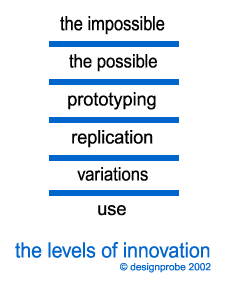|
 |
The Levels of Innovation
 Steps between Invention and Design Steps between Invention and Design
Between the creation of a new category of artifacts (inventions) and the design of new types of artifacts (design), there are a number of steps along the way. I propose ‘The Innovation Path’ as a model to describe the changes in thinking and activity that is required to go from ‘invention’ to ‘design’. It is based upon the pattern of development taken by John Harrison in the development of the chronometer and taken from the description of events by Dava Sobel in her book 'Longitude'.
In reality these steps may not be clear or precise and my intention by distinguishing these into distinct steps we can all step closer to being inventors rather than merely designers.
1 The Impossible
The first level of Innovation in this model starts at the ‘Impossible’ (as discussed previously in "The Impossibility of Invention").
2 The Possible
The second level is where a new artifact is created and the impossible becomes ‘Possible’. A new category is created and an new invention is born. In John Harrison’s case it was ‘H-1’, his first chronometer. Whilst this remarkable timepiece did not win him the Longitude Prize we could declare it the first in a new category of artifacts.
3 Prototyping
The third level is ‘Prototyping’. John Harrison’s clocks H-2, H-3 and H-4 were prototypes enhancing the performance of his original clock H-1. Essentially, in this phase, the inventor is looking to improve upon an existing object and make substantial improvements sufficient to prove the idea is viable and practical.
At this level of action, one has a knowledge about certain things that work and some things don’t work. Whilst ‘prototyping’ is spoken in a design context, here I use the term to mean to streamline or enhance the design and is not intended for practical or immediate use. Alternatively, the design process has the intention of usefulness.
4 Replication
The fourth level of innovation is ‘Replication’. In John Harrison’s case, it wasn’t sufficient for him to invent a new device to claim the prize money, he was also asked to create a duplicate of his creation.
This is an interesting step that is not essential and it is useful. To come up with something that that has never before been created requires a certain type of thinking whilst replicating requires less new thinking and very little in the way of new insights.
Also, I suggest the design process requires more ingenuity than merely replicating something. Yet, in the realm of scientific thought, to be able to replicate an experiment is intended to prove that something was not a fluke. In Harrison’s case, particularly since no one else in the world had a contraption like his and very few people understood what he had created (remember our earlier quote that suggested that Harrison had solved a problem of nature with a ticking box), the demand for replication was perhaps a reasonable demand and an obvious next step in proving the value of his invention.
5 Variations
The fifth level of innovation is that of ‘Variations’ and this places us in the domain of design where we are creating new types of things inside an existing category. In John Harrison’s case, his design for H-4 was considered to be too complicated to merely reproduce on a mass scale. Given that the first replication of H-4 took 2 years to complete, this is perhaps not surprising.
It is also appropriate to remind ourselves that Harrison’s invention contained a number of new ideas that could have stood as patents in their own right, including the invention of the bimetallic strip that is still used today as the basis for many thermostat controls and caged ball bearings which are used in numerous machines as a stable and friction-free device. Whilst the intellectual capital had been invested and the ideas stood as physical components to his clocks, each part was not available as a ready to buy, off the shelf component. Each part had to be handcrafted and the clock assembled piece by piece.
In contrast, designing for production and practical use is very different from designing to create a new and unheralded device. It relies upon efficiency, workability, usefulness and practicality.
6 Use
The sixth level of innovation is the use of a designed object. This completes the fulfillment of the impossibility of invention. The user clearly needs to know a different set of knowledge to that of the inventor and the designer. Consider, the difference between driving a car and being a mechanic repairing a car or being an inventor designing a car from scratch.
Further articles in the Longitude series
|
 |
| |
|
|

|
|

